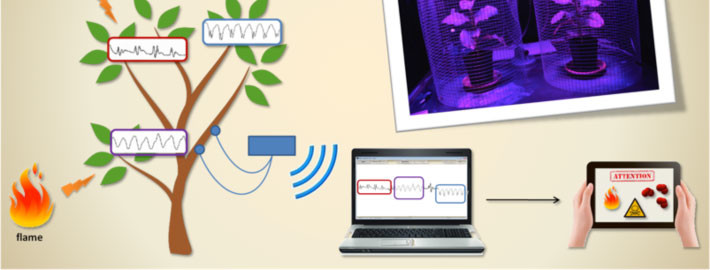Plants as biosensors
 Plants have amazing and significant sensing capabilities: each single root apex can simultaneously and continuously monitor many chemical and physical parameters. While there are artificial sensing devices that can monitor environmental parameters of interest, such as temperature or humidity, we suggest the use of plants themselves as sensing devices. In particular, we claim that plant communities can be used as distributed, eco-compatible, self-sustainable and cost-effective sensing infrastructures for monitoring of the environment.
Plants have amazing and significant sensing capabilities: each single root apex can simultaneously and continuously monitor many chemical and physical parameters. While there are artificial sensing devices that can monitor environmental parameters of interest, such as temperature or humidity, we suggest the use of plants themselves as sensing devices. In particular, we claim that plant communities can be used as distributed, eco-compatible, self-sustainable and cost-effective sensing infrastructures for monitoring of the environment.
In our studies, we map the electrophysiological signals generated by plants to external stimuli, obtaining an effective way of classifying which specific stimulus results into a specific type of electrical response. We consider real field scenarios (e.g. forests, green urban areas, fruit orchards, etc.) in which plants often receive uncontrollable and unpredictable stimuli. Considering multiple points of observations, in which readings from several plants are collected over a wireless network and integrated in a suitable way, we obtain a consistent and global view of an environment of interest. Such system is useful to tackle some relevant problems of the modern society (e.g. air pollution), to help farm management (e.g. irrigation scheduling), and to investigate in deep plant sensing abilities.
LINV projects:
• PLEASED “Plant Employed as Sensing Devices” is a European FP7 research project.
Website http://www.pleased-fp7.eu/
VIDEO youtube: https://www.youtube.com/watch?v=adKiyM7CQSo#t=48
• A.R.I.A. Gli alberi come rilevatori dell’inquinamento ambientale – Regione Toscana
VOLATOM – La rete degli aromi: studio del volatoma vegetale – dalla comunicazione fra piante alla qualità della produzione vegetale” Ente Cassa di Risparmio di Firenze









